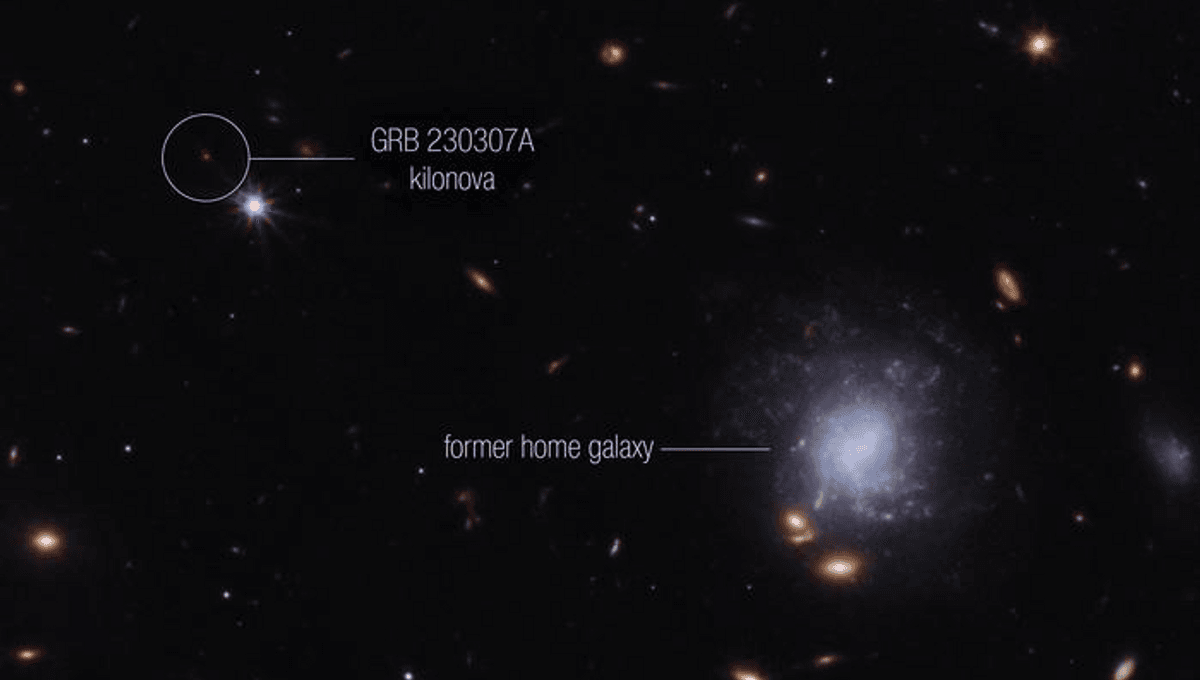
Three heavy elements have been observed in the aftermath of a gamma ray burst (GRB), the first time synthesis of these elements has been observed, helping fill in the origins of more of the periodic table.
The origin of elements with atomic masses heavier than iron has been something of a mystery for a long time. For most of stars’ lives, they turn hydrogen into helium, and towards the end, this can move to somewhat heavier elements. However, to make anything beyond iron takes something more dramatic. It was once thought that supernova accounted for everything heavier, but doubts had crept in even before the first observation of a kilonova resulting from neutron stars colliding.
Both types of stellar explosion are now thought to contribute to the universe’s stock of heavier elements, with the importance of each source varying by element. However, in most cases, this relies on a lot of guesswork, since they have not been detected in the spectrum produced by either sort of explosion.
Now, that has changed, at least for tungsten, selenium, and tellurium, respectively elements number 74, 34, and 52.
“We were searching for the signature of heavy metal synthesis within the Universe and it took a gigantic explosion to allow us to see it,” said Dr Gavin Lamb of Liverpool John Moores University in an emailed statement. The event was the gamma ray burst GRB 230307A – observed by JWST – the second brightest gamma ray burst ever observed.
GRBs can have different causes, but this one was the result of a kilonova, similar to those where we have detected the gravitational waves produced by merging neutron stars. The GRB lasted 200 seconds, making it one of the longer bursts we have seen. It is thought long and short bursts may result from fundamentally different causes, and the association of kilonovas with GRBs lasting more than two seconds is still not well understood.
The afterglow was surprisingly weak considering the power of the burst, but JWST captured it in the mid-infrared 29 and 61 days after the gamma rays reached us. This revealed a spectral line at 2.15 microns, which scientists from 66 institutions worldwide interpret as marking the presence of tellurium, after allowing for the redshift of the galaxy they think hosted the event.
The team calculate the quantity of tellurium produced would be equal to about one thousandth the mass of the Sun – that is about 300 times the mass of the Earth. This helps explain why, while very rare on Earth, tellurium is relatively common in the universe as a whole.
Theoretical modeling suggests kilonovas should produce a lot of tellurium, but this is the first experimental evidence, aside from a more speculative detection in a previous kilonova, AT2017gfo.
A weaker line at 4.5 microns is thought to indicate the presence of tungsten, selenium, or both.
Tellurium is not a well-known element, with its major application being thin-film solar cells and semiconductors. More importantly, its presence probably also indicates the production of elements near it on the periodic table, including its immediate neighbor iodine, essential for making growth-regulating hormones.
Tungsten is best known as the answer to the trivia question: which metal has the highest melting point? Its extreme hardness makes it useful in metal alloys. Selenium is an essential micronutrient for animals added to some foods to prevent deficiencies.
“Just over 150 years since Dmitri Mendeleev wrote down the periodic table of elements, we are now finally in the position to start filling in those last blanks of understanding where everything was made,” Professor Andrew Levan of Radboud University said in another statement.
The study is published in Nature.
Source Link: Creation Of Three Heavy Elements Has Been Observed For First Time Ever